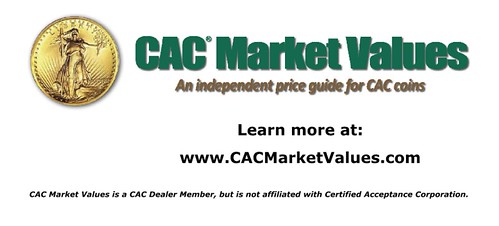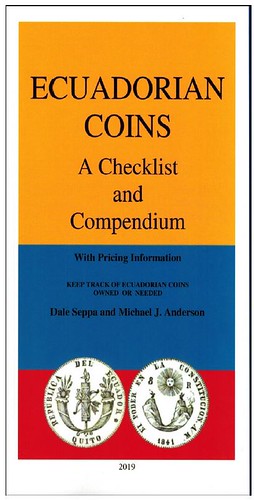
PREV ARTICLE
NEXT ARTICLE
FULL ISSUE
PREV FULL ISSUE
NEW BOOK: ECUADORIAN COINSDale Seppa forwarded this information about his new book on Ecuadorian coins. Thanks and congratulations. -Editor
LCCN 2018908633 By Dale Seppa and Michael J. Anderson. Heavy card covers 4.3/4”(120 mm) by 8.1/2”(215 mm), 132 pages. Over six hundred items are listed and uniquely numbered. Many items are priced based on recent auction results. Illustrated with many high quality drawings. Scheduled for release January 1st. PRE-COLUMBIAN MONEY, COLONIAL COINAGE, WARS OF INDEPENDENCE, REPUBLICAN PROTO-COINAGE, PRE- DECIMAL COINAGE, DECIMAL COINAGE, PRE-DECIMAL GOLD COINAGE, DECIMAL GOLD COINAGE, EARLY PATTERNS & UNUSUAL, DECIMAL PATTERNS & UNUSUAL, SETS, SILVER SPECIAL ISSUES, GOLD SPECIAL ISSUES, TOKENS & SCRIP OF THE GALAPAGOS and COUNTERMARKS OF THE GALAPAGOS Pre-publication single copy orders are $20.00 postpaid for delivery in the United States.. Foreign orders must add $15.00 for postage. Registration for foreign orders is an additional $15.00 if desired. Price will be $30 after January 1, 2019 Two or more copies 20% discount; five or more copies 30% discount; ten or more copies 40% discount; twenty or more copies 50% discount; fifty or more copies 60% discount. All orders are postpaid to addresses in the United States. If desired, insurance is extra. (Actually, I have never lost a book package in the U.S.) PRE-PUBLICATION SPECIAL Order from Dale Seppa, 103 N 6th Ave., Virginia, MN 55792. Personal Checks, Money Orders, Cash (at sender’s risk) or PayPal are accepted. Personal checks will not be deposited until books are ready for shipment. Credit card orders can be processed through PayPal. PayPal orders can be placed by sending the exact amount to daleseppa@gmail.com or by requesting a PayPal invoice from that same email address. BOOK REVIEW It would be hard to beat the team of Dale Seppa and Michael Anderson, if we had to choose two established authors to write a catalogue of Ecuadorian Coins in English. Seppa lived for many years in the capital, Quito, and is still good friends with several top Ecuadorian numismatists, while Anderson spent many years working there, serving as British Vice Consul in the Embassy, from 1965 to 1968. Seppa wrote one of the first catalogs on the coins of this small Andean nation, in 1973, while Anderson published A Numismatic History of Ecuador in 2001. Basically, Dale is a numismatic researcher, while Michael would be better described as a numismatic archivist and author. They have worked together on previous publications as well, and it was exciting to receive the manuscript of this ‘Checklist’ – actually an informal book – and be among the first persons privileged to read it. The first section, ‘Introduction and Comments’, is the only bilingual section of the book, in English and Spanish, and it was fascinating to learn that Ecuador has its own grading and certification service, ‘S.R.N.’, which stands for ‘Servicio de Registro Numismático’, or Numismatic Registry Service. Seppa points out that if a collector possesses a rare or unusual Ecuadorian coin, s/he would be wise to have it ‘registered’. Early Ecuadorian coinage, especially of the pre-decimal pieces struck in the 1860s or before, is notably crude, with many counterfeits. As I discovered while on vacation in 2009, one can see these simply by walking around downtown Quito, where numerous jewelry shops have these early counterfeits displayed in their shop windows. For collectors in the ‘homeland’, then, the authors seriously advise having earlier pieces ‘registered’, which is much more convenient when done within the country. Seppa states that someday, all or nearly all rare Ecuadorian coins will be certified. I would suggest that if this is so, it is because doubts arise as to the genuineness of many early pieces, rather than as to whether a given coin is in MS 63 or MS 65 condition. Curious collectors are advised to check out the service’s website, ‘srncoin.com’, and this suggestion is already a good start. The earliest section on the actual coinage of Ecuador is termed ‘Colonial Coinage’, and since the closest major Latin American colonial mints were in Bogotá, Lima and Potosí, these tend to be proclamation pieces honoring the coronations of the Spanish kings. Often, these are referenced to the pioneering works by Betts or Medina, or coins from these mints which bear a connection to Quito. These include an unusual denomination, of a seven and one half reales counterstamp on an eight reales piece of 1650 of Potosí. This alludes to the ‘Potosí Scandal’ of the mid-seventeenth century, in which a number of coins were found to be underweight or of insufficient fineness, leading to the trial and execution of various mint employees. Following this section, the War of Independence from Spain is covered, with its numismatic legacy. Here is to be found the first coin I have owned personally, a ‘borderline’ piece also often ascribed to Colombia, since it was minted in Pasto, a two reales coin of 1822, P O assayer, KMA1. Seppa terms this coin as “considered by most collectors to be the first coin of Ecuador...very scarce and getting scarcer”, and illustrates one, with the truthful disclaimer that “Very few readers of this book will be able to acquire one in the superb condition of the Heritage Auctions piece”. I must concur, because of the two pieces I have owned in the last 40 years, both were holed, scratched and poorly struck. They were pleasing to me, however, and by no means expensive. Such finds are one of the many joys of collecting coins of 19th century Latin America. Further sections include Republican Proto-Coinage, Pre-Decimal Coinage, Decimal Coinage, Pre-Decimal Gold Coinage, and Decimal Gold Coinage, basically following the structure found in the Krause-Mishler catalogs. The prices cited, happily from known sales or auction results, must have taken years to gather. One of the most fascinating aspects of coins of Ecuador is that after the Quito mint closed in 1863, following a period of civil strife and a major earthquake, coinage production did not stop by any means. It was, rather, continued in what must be one of the most ‘widespread’ coinages of all time, a process which has continued since ‘dollarization’ in the year 2000. Coins and banknotes of the U.S. have been the norm ever since, including above all the Sacagawea dollars, but not their Presidential equivalents. Sacagawea, as several salespeople were quick to remind me, is considered by most Ecuadoreans as ‘one of ours’, believed to be an Incan princess, whereas even in museum shops my Presidential dollars were rejected, as ‘one of yours’. It was hard to argue that point when holding a dollar coin picturing George Washington. Coins have also been made in Canada and Mexico City since the year 2000. Earlier coinage was produced in many, many places, beginning with the Heaton Mint following decimalization in the late 1800s, and including mints as varied as Santiago, Lima, Birmingham, Philadelphia, London, and several mints in Germany and elsewhere. Although Ecuador itself is small and situated at the Earth’s ‘Half-Way Point’, known as ‘La mitad del mundo’, a globe with lines originating at every mint which has struck coins for Ecuador would cover much of the earth’s surface. Where the authors cannot prove origins they find doubtful, such as certain pieces ascribed to the Galapagos Islands, they come right out and say so, always admitting that not everything is known. This is, while perhaps unduly modest, correct, although Seppa and Anderson know as much as anyone. By far the most interesting part of this book to me are the lengthy sections on ‘Early Patterns & Unusual Coinage’ and ‘Decimal Patterns and Unusual Coinage’, in which we can see the results of a lifetime of careful record keeping on the parts of Seppa, Anderson, and a number of colleagues the world over. We read, for example, that any and all collectors are invited to come forward with their experiences finding coins of Ecuador which are off-center or contain die breaks. Although collectors of world coins are hardly surprised to find such minor varieties on coins of any country, in any age, a major die crack on a 1 Sucre piece of 1979 is pictured with the commentary “Several of my colleagues were kind enough to go over their stock and no other Ecuadorean coin with a die break was found. None of us remember die breaks on any modern Ecuadorian coins of any date”. Similarly, almost no coins with major die doubling could be accounted for, and only one piece was found to be more than 5% off center. Since I cannot think of another country for which these claims could be made, despite having dabbled in, or seriously studied the coins of many countries, this is highly unusual and important information. Equally interesting were the many coins which can only be described as mules or off-metal strikes, some bearing a reverse of commemorative coins of modern China, Korea, or even a planchet from Uganda. The mules of China are especially interesting, as they depict traditional, symbolic renditions of ‘ethnicities’ – such as a ‘Kyrgyz Deer’ – with the motto “Fifty six ethnic minorities united and prosperous in China”. Often, these are struck in silver, many with the incorrectly spelled denomination ‘Un Sucer’, instead of the correct ‘Sucre’. Since these are dated 2005, long after the ‘Sucre’ denominated coins were abandoned, one can imagine that someday, somewhere, someone will try to assemble a complete set, if this is indeed possible. We know that China is accused of massive counterfeiting, and yet these pieces, fantasies or inventions that they may well be, do not seem to fit into any one category. I notice that in the Krause-Mishler – actually Colin Bruce’s - work “Unusual World Coins”, only one piece is listed under Ecuador, and it shows a Galapagos tortoise. That would be an image I would find entirely ‘usual’, considering the numerous, and more surprising alternatives presented. I must admit I am not an objective reviewer, when it comes to Dale Seppa. This is perhaps because in a numismatic universe which is nothing if not commercialized, he has always been of a different breed. He personally authored the first series of ‘country books’ for the coins and banknotes of many a Latin American land, while working with Al Almanzar’s auction house in the 1960s and 70s. To this day, in the auction catalogs of European firms, his works can be found in the bibliography of some major auction houses.   Wayne Homren, Editor The Numismatic Bibliomania Society is a non-profit organization promoting numismatic literature. See our web site at coinbooks.org. To submit items for publication in The E-Sylum, write to the Editor at this address: whomren@gmail.com To subscribe go to: https://my.binhost.com/lists/listinfo/esylum All Rights Reserved. NBS Home Page Contact the NBS webmaster 
|
